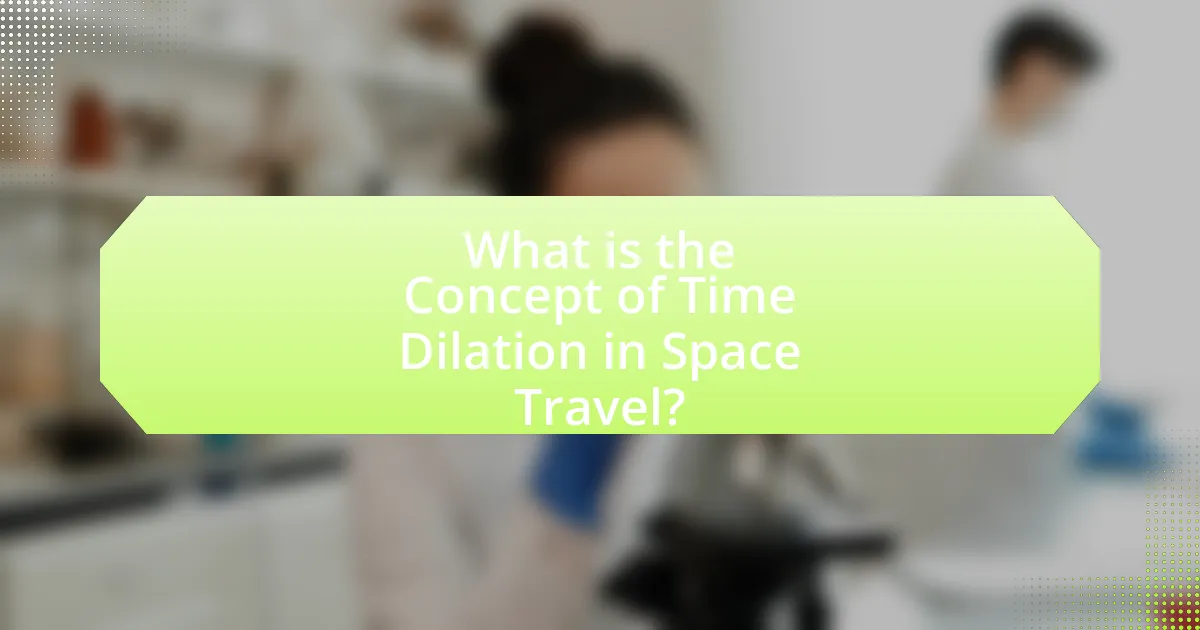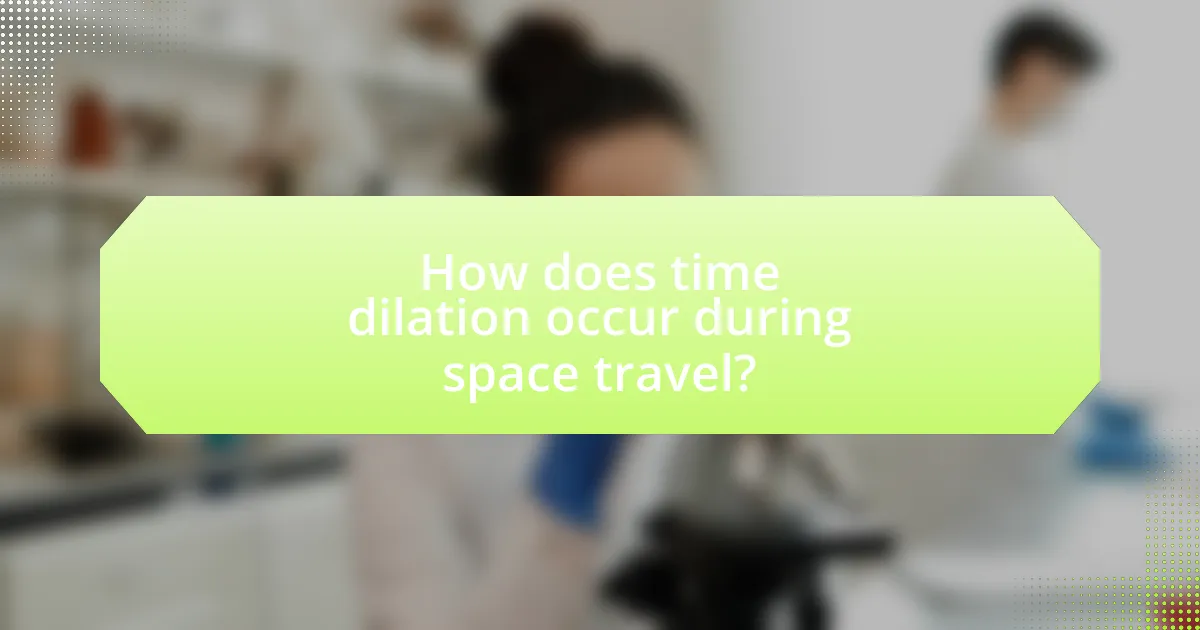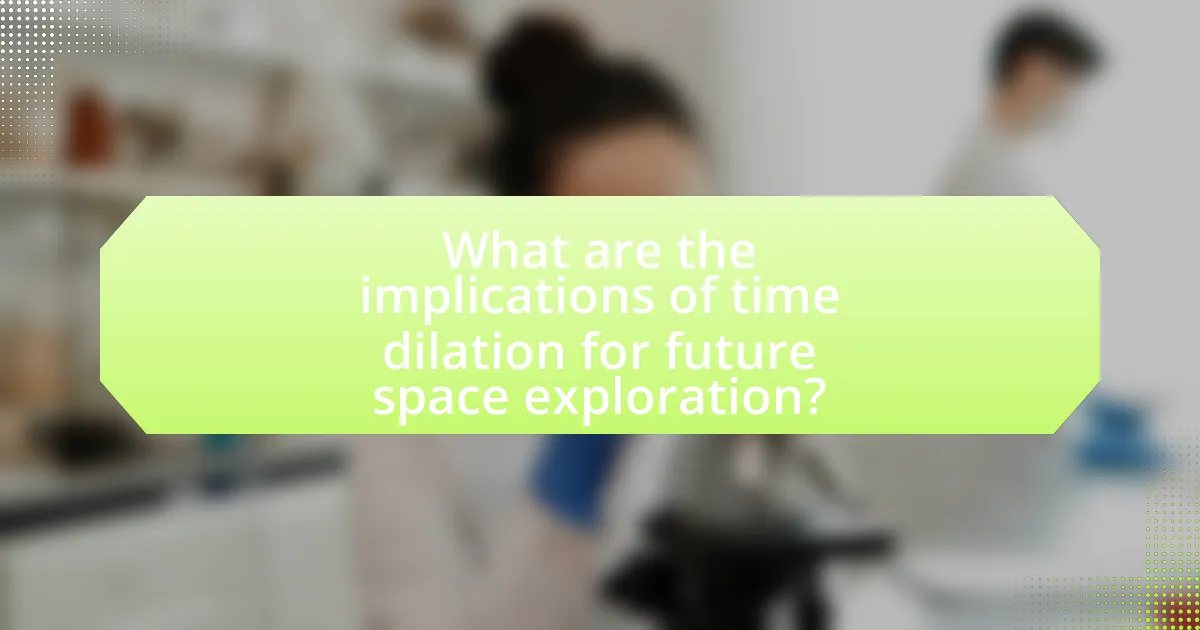The concept of time dilation in space travel refers to the phenomenon where time passes at different rates for observers in varying gravitational fields or relative velocities, as described by Einstein’s theory of relativity. This article explores the scientific principles underlying time dilation, including its definitions, implications for astronauts, and effects on long-duration space missions. It discusses how time dilation influences communication with Earth, the factors contributing to this phenomenon, and the practical considerations for future space exploration. Additionally, it highlights the significance of time dilation in mission planning and the psychological effects on astronauts, providing insights into the challenges and preparations necessary for interstellar travel.

What is the Concept of Time Dilation in Space Travel?
Time dilation in space travel refers to the phenomenon where time passes at different rates for observers in different gravitational fields or relative velocities. According to Einstein’s theory of relativity, as an object approaches the speed of light, time for that object slows down relative to a stationary observer. This effect has been confirmed through experiments, such as those involving atomic clocks on fast-moving jets, which showed that time measured on the moving clocks was less than that on stationary clocks. Thus, astronauts traveling at high speeds in space would age more slowly compared to people on Earth, illustrating the practical implications of time dilation in space travel.
How is time dilation defined in the context of space travel?
Time dilation in the context of space travel is defined as the phenomenon where time passes at different rates for observers in different frames of reference, particularly when one is moving at a significant fraction of the speed of light. According to Einstein’s theory of relativity, as an object approaches the speed of light, time for that object slows down relative to a stationary observer. This effect has been confirmed through experiments, such as those involving atomic clocks on fast-moving jets, which show that time measured on the moving clock is less than that measured on a stationary clock.
What scientific principles underpin the concept of time dilation?
The scientific principles underpinning the concept of time dilation are rooted in Einstein’s theory of relativity, specifically the special and general theories. Special relativity posits that time is relative and can vary for observers in different inertial frames of reference, particularly at high velocities approaching the speed of light. This leads to the phenomenon where a moving clock ticks slower compared to a stationary clock, a result confirmed by experiments such as those involving atomic clocks on fast-moving jets. General relativity further expands on this by demonstrating that time is affected by gravitational fields; clocks in stronger gravitational fields run slower than those in weaker fields, as evidenced by experiments using precise timekeeping satellites in varying gravitational conditions.
How does Einstein’s theory of relativity relate to time dilation?
Einstein’s theory of relativity directly relates to time dilation by establishing that time is not a constant and can vary depending on relative speed and gravitational fields. According to the theory, as an object approaches the speed of light, time for that object slows down relative to a stationary observer, a phenomenon confirmed by experiments such as those involving atomic clocks on fast-moving jets, which showed measurable time differences. This principle is crucial for understanding the effects of time dilation in space travel, where astronauts traveling at high velocities experience less passage of time compared to people on Earth.
Why is time dilation significant for astronauts and space missions?
Time dilation is significant for astronauts and space missions because it affects the perceived passage of time for individuals traveling at high velocities or in strong gravitational fields. According to Einstein’s theory of relativity, time moves slower for objects in motion compared to those at rest, which means astronauts on long-duration space flights experience less time passing relative to people on Earth. For instance, the twin paradox illustrates this concept, where an astronaut traveling at near-light speed would age more slowly than their twin remaining on Earth. This effect has practical implications for mission planning, communication, and the synchronization of time-sensitive operations, ensuring that astronauts can effectively coordinate with mission control and maintain accurate timelines during their missions.
What effects does time dilation have on long-duration space travel?
Time dilation significantly affects long-duration space travel by causing astronauts to age more slowly relative to people on Earth. This phenomenon occurs due to the effects of special relativity, where time passes at different rates for observers in different frames of reference, particularly at high velocities. For instance, if a spacecraft travels at a speed close to the speed of light, time for the astronauts onboard would elapse more slowly compared to time experienced on Earth.
An example of this is the twin paradox, where one twin traveling at relativistic speeds would return younger than their sibling who remained on Earth. Calculations show that at 99% the speed of light, a journey lasting five years for the traveling twin could equate to approximately 35 years passing on Earth. This discrepancy in aging could have profound implications for long-term missions, affecting crew dynamics, mission planning, and the psychological well-being of astronauts as they experience time differently than their families and society back home.
How does time dilation impact communication with Earth?
Time dilation significantly impacts communication with Earth by causing delays in message transmission due to differences in the passage of time experienced by observers in different gravitational fields or relative velocities. For instance, astronauts traveling at high speeds or in strong gravitational fields experience time more slowly compared to people on Earth, leading to a lag in communication. This phenomenon is predicted by Einstein’s theory of relativity, which states that time is not absolute and can vary based on speed and gravity. As a result, messages sent from a spacecraft may take longer to reach Earth than expected, complicating real-time communication and coordination for missions.

How does time dilation occur during space travel?
Time dilation during space travel occurs due to the effects of relativity, specifically as described by Albert Einstein’s theory of special relativity. When a spacecraft travels at speeds approaching the speed of light, time for the travelers on the spacecraft slows down relative to observers on Earth. This phenomenon is quantified by the Lorentz factor, which indicates that as velocity increases, the passage of time decreases for the moving observer. For example, at 99% of the speed of light, time would pass significantly slower for astronauts compared to people on Earth, leading to scenarios where astronauts could age less than those who remained on Earth. This effect has been confirmed through experiments involving high-speed particles and precise atomic clocks, demonstrating that time is not an absolute measure but is influenced by relative motion.
What factors contribute to time dilation in space environments?
Time dilation in space environments is primarily influenced by two factors: relative velocity and gravitational fields. According to Einstein’s theory of relativity, as an object approaches the speed of light, time for that object slows down relative to a stationary observer. This effect has been confirmed through experiments with particles moving at high speeds, such as those conducted at CERN, where muons traveling close to light speed exhibit significantly longer decay times than expected. Additionally, strong gravitational fields, as described by general relativity, cause time to pass more slowly in regions of higher gravity. For instance, clocks on satellites in lower gravitational fields, like those in orbit around Earth, run faster compared to clocks on the surface, a phenomenon that has been measured and is crucial for the accuracy of GPS technology.
How does velocity affect the experience of time for astronauts?
Velocity significantly affects the experience of time for astronauts due to the phenomenon known as time dilation, as described by Einstein’s theory of relativity. When astronauts travel at speeds approaching the speed of light, time for them slows down relative to observers on Earth. For instance, the twin paradox illustrates this concept: if one twin travels in a spacecraft at a high velocity while the other remains on Earth, the traveling twin will age more slowly than the Earth-bound twin. This effect has been confirmed through experiments, such as those involving atomic clocks flown on jets, which showed that clocks on fast-moving aircraft ticked more slowly compared to stationary clocks. Thus, the higher the velocity of the spacecraft, the more pronounced the time dilation effect experienced by astronauts.
What role does gravitational field strength play in time dilation?
Gravitational field strength significantly influences time dilation, as stronger gravitational fields cause time to pass more slowly relative to weaker fields. According to Einstein’s General Theory of Relativity, time runs slower in stronger gravitational fields due to the curvature of spacetime. For example, a clock on the surface of Earth, where gravitational field strength is approximately 9.81 m/s², ticks more slowly compared to a clock in a region of negligible gravity, such as in deep space. This effect has been experimentally validated through observations, such as the Hafele-Keating experiment, where atomic clocks flown around the Earth experienced measurable time differences due to variations in gravitational field strength.
How can time dilation be measured in space missions?
Time dilation in space missions can be measured using precise atomic clocks placed on spacecraft and compared to clocks on Earth. For instance, during the Hafele-Keating experiment in 1971, atomic clocks were flown around the world on commercial airliners, and the results showed that the clocks on the planes recorded less elapsed time than those on the ground, confirming predictions of Einstein’s theory of relativity. This experiment demonstrated that time dilation occurs due to differences in velocity and gravitational fields, which can be quantified in space missions by comparing the time recorded by onboard clocks with those on Earth after the mission concludes.
What instruments are used to observe time dilation effects?
Atomic clocks are the primary instruments used to observe time dilation effects. These highly precise timekeeping devices measure the vibrations of atoms, typically cesium or rubidium, to determine time intervals. Experiments, such as those conducted with atomic clocks flown on aircraft or placed at different altitudes, have demonstrated time dilation as predicted by Einstein’s theory of relativity. For instance, the Hafele-Keating experiment in 1971 involved atomic clocks on commercial flights, which confirmed that clocks at higher speeds or gravitational fields experienced time differently, validating the concept of time dilation.
How do scientists verify time dilation through experiments?
Scientists verify time dilation through experiments by using precise atomic clocks placed in different gravitational fields or moving at high velocities. For instance, the Hafele-Keating experiment in 1971 involved flying atomic clocks on commercial airliners around the world and comparing them to stationary clocks on the ground. The results showed that the clocks on the planes recorded less elapsed time than those on the ground, confirming predictions made by Einstein’s theory of relativity. This experiment provided concrete evidence of time dilation effects due to both velocity and gravitational differences, validating the concept in practical scenarios.

What are the implications of time dilation for future space exploration?
Time dilation significantly impacts future space exploration by altering the perception of time for astronauts traveling at high velocities or in strong gravitational fields. As described by Einstein’s theory of relativity, time moves slower for objects in motion compared to those at rest; thus, astronauts on long-duration missions could age more slowly than people on Earth. For instance, a mission to a distant star at near-light speed could result in astronauts experiencing only a few years of travel time while decades or centuries pass on Earth. This discrepancy necessitates careful planning for mission duration, communication with Earth, and the psychological effects of time perception on crew members. Understanding these implications is crucial for the design of future interstellar missions and the management of human resources in space exploration.
How might time dilation influence the design of future spacecraft?
Time dilation will significantly influence the design of future spacecraft by necessitating advanced propulsion systems and life support technologies to accommodate the effects of relativistic speeds. As spacecraft approach a significant fraction of the speed of light, time for the crew will pass more slowly compared to observers on Earth, which requires careful planning for mission duration and crew health. For instance, the design of spacecraft may incorporate systems that allow for extended life support and psychological well-being, as missions could last years from the perspective of Earth while only months or weeks pass for the crew. Additionally, propulsion systems must be engineered to achieve these high velocities efficiently, as demonstrated by theoretical models like the Alcubierre warp drive, which suggests a method of faster-than-light travel while mitigating time dilation effects.
What considerations must be made for crewed missions to distant planets?
Crewed missions to distant planets require careful consideration of life support systems, radiation protection, psychological factors, and time dilation effects. Life support systems must ensure a sustainable supply of air, water, and food for extended periods, as missions could last several years. Radiation protection is critical because astronauts will be exposed to higher levels of cosmic radiation beyond Earth’s atmosphere, necessitating robust shielding in spacecraft design. Psychological factors, including crew dynamics and mental health, must be addressed to mitigate stress and isolation during long-duration missions. Time dilation, as described by Einstein’s theory of relativity, indicates that time will pass differently for astronauts traveling at high speeds compared to those on Earth, impacting mission planning and communication. These considerations are essential for the success and safety of crewed missions to distant planets.
How could time dilation affect the planning of interstellar travel?
Time dilation could significantly impact the planning of interstellar travel by altering the perceived duration of journeys for travelers compared to observers on Earth. As spacecraft approach the speed of light, time for the travelers would slow relative to time experienced on Earth, meaning that while years may pass for those on the spacecraft, decades or centuries could pass on Earth. This discrepancy necessitates careful consideration of mission timelines, crew health, and communication strategies, as well as the potential for generational shifts in society back home. For instance, according to Einstein’s theory of relativity, at 99% the speed of light, time would pass approximately 7 times slower for the travelers than for those on Earth, which could lead to significant challenges in mission planning and expectations for return.
What practical tips can be applied to understand time dilation in space travel?
To understand time dilation in space travel, one practical tip is to study Einstein’s theory of relativity, which explains how time is affected by speed and gravity. Specifically, the closer an object moves to the speed of light, the slower time passes for it relative to a stationary observer. This phenomenon has been experimentally validated through observations such as the Hafele-Keating experiment, where atomic clocks flown around the Earth showed a measurable difference in elapsed time compared to stationary clocks. Additionally, using simulations or visual aids that depict scenarios of high-speed travel can help illustrate the effects of time dilation, making the concept more tangible.
How can aspiring astronauts prepare for the effects of time dilation?
Aspiring astronauts can prepare for the effects of time dilation by understanding its implications on their missions and training their mental resilience. Time dilation, a consequence of Einstein’s theory of relativity, indicates that time moves slower for individuals traveling at high speeds compared to those on Earth. For instance, astronauts aboard the International Space Station experience a time difference of approximately 0.01 seconds per six months due to their velocity and gravitational effects.
To effectively prepare, aspiring astronauts should engage in simulations that mimic the psychological and physiological challenges of long-duration space travel, including the perception of time. Training programs that focus on stress management, adaptability, and teamwork can help them cope with the altered experience of time. Additionally, studying the scientific principles behind time dilation can enhance their understanding and readiness for the unique conditions they will face in space.
What resources are available for further learning about time dilation?
Books, online courses, and scientific articles are valuable resources for further learning about time dilation. Notable books include “Relativity: The Special and General Theory” by Albert Einstein, which provides foundational insights into the concept. Online platforms like Coursera and edX offer courses on relativity and astrophysics that cover time dilation in detail. Additionally, peer-reviewed articles in journals such as “Physical Review Letters” and “The Journal of Cosmology and Astroparticle Physics” present current research findings and theoretical advancements related to time dilation. These resources collectively enhance understanding of the phenomenon within the context of space travel.
